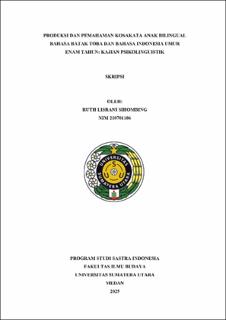| dc.description.abstract | This research discusses the “Production and Understanding of Vocabulary of
Bilingual Children in Toba Batak and Indonesian Language Aged Six Years” at
Paud Sion Kids Kindergarten in Buluduri Village, Laeparira District, Dairi
Regency. The purpose of this study is to describe children's ability to produce and
understand vocabulary in two languages used in daily life. This study is based on
the theory of generative linguistics proposed by Noam Chomsky, focusing on two
main concepts, namely competence (internal knowledge of language) and
performance (real use of language in communication situations). The method used
in data collection is the listening method, which is followed by the listening
method. The method is supported by several basic techniques, namely fishing
techniques, recording techniques, and note-taking techniques. The data were
analyzed using the commensurate method, with the basic technique of sorting the
determining elements (PUP) which has referential sorting power, and continued
with the comparative linking technique (HBS) to identify similarities in meaning
and structure between languages. The results show that six-year-old bilingual children
have been able to produce and understand vocabulary in two languages, with details:
noun data, namely: sharpener, paper, money, hoe, wood, rice, cupboard, glass, iron,
lamp. Verb data: cry, sleep, sit, eat, wake up, hug, cook, dig, hit, laugh. Adjective data
are: dragonfly shape, wet, cold, dirty, sick, fat, hot, dark, spicy, angry. And task words
include prepositions, namely: in, to, from, conjunction data, namely: because and
particles, namely: lah. Based on Noam Chomsky's genetic theory in this study between
competence and performance goes quite well. | en_US |


